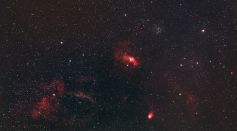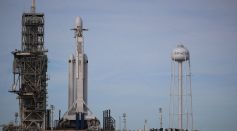SPACE

Falcon Heavy Soars Again: Witness History With SpaceX's Seventh Launch of the Mighty Rocket
SpaceX Is Preparing World’s 2 Biggest Rockets Falcon Heavy, Starship for Their Next Flights
NASA Distributes $150 Million to 11 US Organizations Supporting Human Explorations on the Moon

Exploding Invisible Boson Stars: Scientists Explore Whether Bosenovas Behave Like Supernovas

NASA DART Spacecraft Crashed In Asteroid Dimorphos Resulting Into 37 Boulders Ejected Amid First Ever Planetary Defense Test Mission

'Star Wars Comet' 12 P/Pons-Brook Is Scheduled for a Total Solar Eclipse After Its 71-Year Orbit
ESO's New Infrared Image Features Space's Glowing Region Chamaeleon Complex
Water Vapor Detected in Baby Planet System Sheds Light Into Its Potential Habitability, Earth's Origins
Earth-Sized Rogue Planets 20 Times More Common Than Stars in Milky Way [Study]

SpaceX Falcon Heavy Rocket Set To Launch on Wednesday, Carrying Communication Satellites

NASA, CIA Investigate Man From North Carolina Who Claims To Encounter Extraterrestrials With Red Eyes, Receive Regular Visits From Glowing Orbs

Venus, Mercury Will Meet; Delta Aquariids Meteor Shower Will Peak This Week

Voyager Golden Record 1977 Master Copy Is Up for Auction Starting at $300,000

Elon Musk’s SpaceX Launch of Falcon 9 Rocket Punctures a Temporary Hole in Earth’s Ionosphere
Most Popular

Largest Known Volcanic Aquifer Discovered Beneath Oregon's Cascades

New 'Supergiant' Sea Bug Found in South China Sea, Named After Darth Vader

Mediterranean Sea Was Refilled by a Catastrophic Flood Millions of Years Ago

Mysterious Cosmic Waves That Sound Like Birds Detected in Unexpected Space Region




